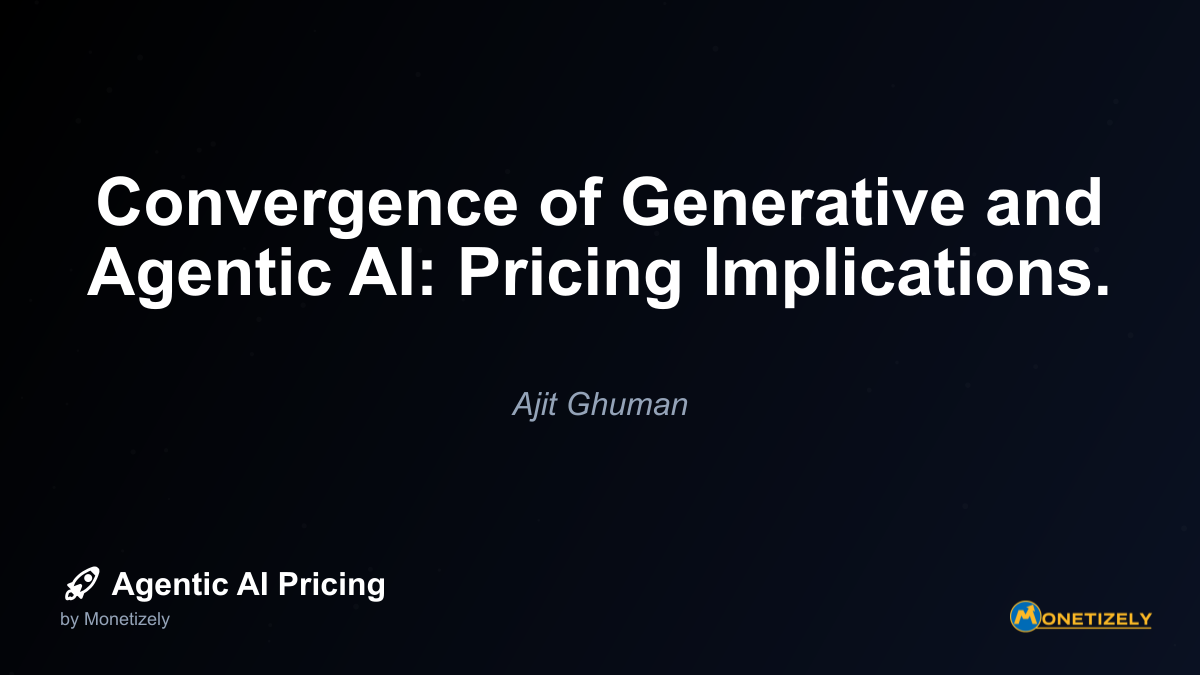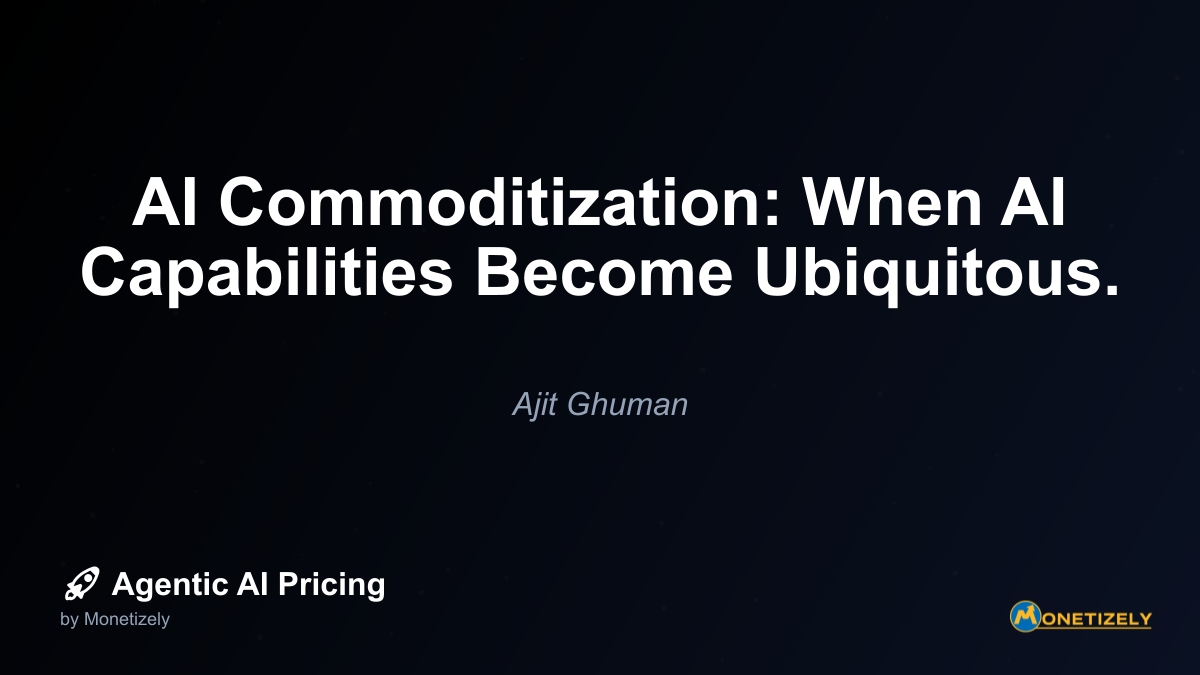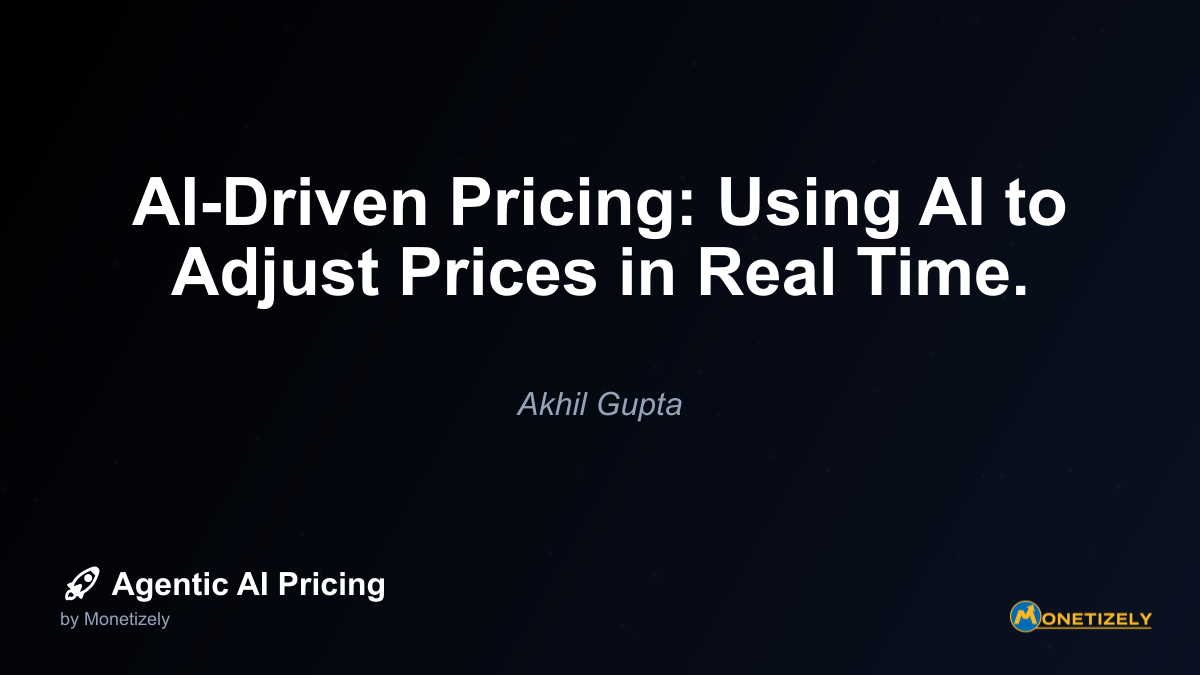· Ajit Ghuman · Emerging Trends · 10 min read
Convergence of Generative and Agentic AI: Pricing Implications.
AI and SaaS Pricing Masterclass
Learn the art of strategic pricing directly from industry experts. Our comprehensive course provides frameworks and methodologies for optimizing your pricing strategy in the evolving AI landscape. Earn a professional certification that can be imported directly to your LinkedIn profile.

Today, we’re witnessing a significant shift as the once-clear boundaries between generative and agentic AI systems are dissolving. Several factors are driving this convergence:
1. Evolution of Large Language Models (LLMs)
Modern LLMs have transcended their original purpose of text generation. Systems like GPT-4 and Claude can now:
- Generate content across multiple modalities
- Reason through complex problems
- Follow multi-step instructions
- Maintain context across extended interactions
- Interface with external tools and APIs
These capabilities extend far beyond simple content creation, enabling these models to function as agents that can take meaningful actions based on user requests.
2. Integration of Tool Use and Function Calling
A critical development in the convergence journey has been the integration of tool use capabilities into generative models. By connecting LLMs to external systems through APIs, these models can now:
- Search the web for current information
- Execute code to perform calculations
- Interact with databases to retrieve or modify information
- Control other software applications
- Process and analyze documents
This functionality transforms what were once purely generative systems into hybrid models that can both create content and take actions in digital environments.
3. Rise of Autonomous Agents
The most advanced manifestation of this convergence is the emergence of autonomous AI agents—systems that can pursue complex goals with limited human supervision. These agents combine:
- Generative capabilities to process and produce information
- Planning abilities to break down tasks into manageable steps
- Memory systems to maintain context and learn from experience
- Tool-using skills to interact with digital systems
- Decision-making frameworks to determine optimal actions
Examples like AutoGPT, BabyAGI, and commercial offerings from companies like Anthropic and OpenAI demonstrate how generative foundation models can be transformed into agentic systems through thoughtful architecture and integration.
Pricing Challenges in the Convergence Era
The merging of generative and agentic capabilities creates several unique pricing challenges:
1. Value Attribution Complexity
When a system both generates content and takes actions, how do you determine which aspect delivers more value? Consider an AI assistant that:
- Drafts an email (generative function)
- Schedules a meeting based on that email (agentic function)
- Updates a CRM with the interaction details (agentic function)
- Generates a summary of key points to prepare for (generative function)
Attributing value to each component becomes increasingly difficult as the boundaries blur, complicating pricing decisions.
2. Resource Utilization Differences
Generative and agentic functions can have dramatically different resource profiles:
- Generative tasks typically consume significant computational resources during content creation but require minimal ongoing resources.
- Agentic tasks might use fewer resources per action but require continuous monitoring, decision-making, and interaction with external systems over time.
These differences make it challenging to apply uniform usage-based pricing models across hybrid capabilities.
3. Risk and Liability Considerations
Agentic functions that take actions on behalf of users carry inherently different risk profiles than generative functions:
- Content generation might raise concerns about copyright, accuracy, or appropriateness
- Autonomous actions might create financial, legal, or operational risks if executed incorrectly
These varying risk profiles suggest that pricing models may need to account for the different liability exposures associated with different functions.
Emerging Pricing Models for Converged AI Systems
As the technology landscape evolves, several innovative pricing approaches are emerging to address the challenges of converged AI systems:
1. Hybrid Consumption Models
These models combine elements of both generative and agentic pricing approaches:
Base subscription + usage components: A core subscription fee covers basic functionality, with separate usage-based charges for generative outputs (e.g., tokens generated) and agentic actions (e.g., API calls made or tasks completed).
Credit-based systems with differential weighting: Users purchase credits that can be spent on both generative and agentic functions, with different functions consuming different amounts of credits based on their complexity, resource requirements, and value.
Example: An AI writing assistant might charge a base subscription of $29/month, with additional charges of $0.01 per 1,000 tokens generated and $0.05 per document edited and formatted (an agentic action).
2. Outcome-Based Pricing
These models tie pricing directly to the value created rather than the specific functions used:
Goal achievement pricing: Users pay based on successful completion of defined objectives, regardless of whether those objectives required generative capabilities, agentic capabilities, or both.
Value-share arrangements: The provider receives a percentage of the measurable value created (e.g., revenue generated, costs saved, time reduced).
Example: A marketing AI that both generates ad copy and autonomously optimizes campaign performance might charge 5% of the incremental revenue generated above the customer’s baseline.
3. Capability Tiers
These models segment offerings based on the sophistication of both generative and agentic capabilities:
Function-based tiers: Different pricing tiers offer access to increasingly advanced generative and agentic capabilities.
Domain-specific packages: Specialized pricing for particular use cases that require specific combinations of generative and agentic functions.
Example: A legal AI assistant might offer a basic tier ($99/month) for document generation, a professional tier ($299/month) that adds contract analysis, and an enterprise tier ($999/month) that includes autonomous negotiation assistance.
4. Risk-Adjusted Pricing
These models incorporate the different risk profiles of generative versus agentic functions:
Action authorization levels: Pricing varies based on the degree of autonomy granted to the AI, with higher prices for greater autonomy (and thus higher risk).
Insurance-linked pricing: Pricing includes built-in protection against potential damages from AI actions, with premiums varying based on the scope and nature of authorized actions.
Example: An AI financial assistant might charge $50/month for investment recommendations (generative), $100/month for the ability to execute trades with approval (limited agency), and $250/month for fully autonomous portfolio management (full agency), with each tier including appropriate risk protections.
Strategic Considerations for Providers
For companies developing converged AI systems, several strategic considerations should guide pricing decisions:
1. Value Mapping
Before setting prices, map the complete value chain of your AI solution:
- Identify all generative and agentic components
- Assess the relative value contribution of each component
- Understand how these components interact to create compound value
- Determine which aspects customers perceive as most valuable
This mapping process provides the foundation for aligning pricing with actual and perceived value.
2. Customer Segmentation
Different customer segments may value generative and agentic capabilities differently:
- Enterprise customers might place premium value on agentic capabilities that automate business processes
- Creative professionals might prioritize generative capabilities that enhance their creative output
- Small businesses might value balanced systems that can both generate content and perform simple tasks
Segmented pricing strategies can address these varying preferences while maximizing revenue potential.
3. Competitive Positioning
As the market for converged AI systems matures, positioning relative to competitors becomes crucial:
- Generative-focused providers adding agentic capabilities must determine whether to price these as premium add-ons or included features
- Agentic-focused providers incorporating generative capabilities face similar decisions in the opposite direction
- Purpose-built converged systems must establish pricing that reflects their integrated value proposition
The competitive landscape will continue to evolve rapidly, requiring regular reassessment of pricing strategies.
4. Scalability Considerations
Pricing models must account for how costs and value scale as usage increases:
- Generative functions often scale linearly with usage
- Agentic functions may have more complex scaling characteristics, particularly when they involve continuous monitoring or decision-making
Sustainable pricing models must balance accessibility for new users with profitability at scale.
Case Studies in Converged AI Pricing
Case Study 1: The Evolution of OpenAI’s Pricing
OpenAI’s pricing journey illustrates the challenges of pricing converged AI systems:
- Initial GPT models used straightforward token-based pricing focused purely on generative capabilities
- Introduction of ChatGPT Plus moved to a subscription model for enhanced generative capabilities
- GPT-4 with browsing and plugins introduced limited agentic capabilities under the same subscription model
- Function calling and API access created new pricing considerations as developers built more agentic applications
- Assistant API introduced explicitly agentic capabilities, requiring new pricing approaches
As OpenAI’s offerings have evolved from purely generative to increasingly agentic, their pricing models have needed to adapt accordingly.
Case Study 2: Anthropic’s Claude Approach
Anthropic has taken a slightly different approach with Claude:
- Introduced tiered models (Claude Instant vs. Claude 2) with different capabilities and pricing
- Emphasized safety and reliability as key differentiators
- Gradually introduced tool use and agentic capabilities
- Maintained relatively simple pricing while expanding capabilities
Anthropic’s approach suggests that maintaining pricing simplicity while gradually introducing converged capabilities can be an effective strategy during market development.
Case Study 3: Vertical-Specific Converged AI
Several companies have developed industry-specific solutions that combine generative and agentic capabilities:
- Legal AI platforms that both generate contract language and autonomously review documents
- Marketing AI systems that create content and optimize campaign performance
- Design AI tools that generate visual assets and automatically adapt them to different formats
These vertical solutions often employ outcome-based pricing tied to industry-specific metrics, demonstrating how pricing can be tailored to specific use cases that benefit from converged capabilities.
The Future of Pricing in Converged AI
Looking ahead, several trends are likely to shape pricing strategies for converged AI systems:
1. Increasing Price Discrimination
As providers gain more data about how different customer segments use and value various aspects of converged AI systems, we can expect more sophisticated price discrimination:
- Usage-pattern-based pricing: Customized pricing based on observed patterns of generative versus agentic usage
- Value-based segmentation: Different pricing tiers based on measured value creation
- Dynamic pricing: Adjusting prices in real-time based on system utilization and customer value
These approaches will help maximize revenue while making converged AI systems accessible to a broader range of customers.
2. Ecosystem-Based Pricing
As converged AI systems become platforms that support third-party extensions, ecosystem-based pricing models will emerge:
- Marketplace revenue sharing: Platform providers taking a percentage of revenue from specialized AI agents built on their platforms
- API access tiers: Different pricing for developers based on the sophistication of agentic capabilities they can access
- Integration-based pricing: Pricing that varies based on which external systems the AI can interact with
These models will distribute value across ecosystems of converged AI providers and developers.
3. Regulatory Influences
Emerging regulations around AI will inevitably impact pricing structures:
- Liability-driven pricing: Higher prices for uses that carry greater regulatory risk
- Transparency requirements: More explicit pricing for different AI capabilities as regulations demand clearer disclosure
- Data usage considerations: Pricing adjustments based on data privacy requirements and limitations
Providers will need to build regulatory considerations into their pricing strategies from the outset.
Practical Guidance for Businesses
For businesses evaluating converged AI systems, consider these practical steps:
1. Conduct a Value Assessment
Before selecting a pricing model:
- Identify specific use cases where converged AI creates value
- Quantify the potential impact on revenue, costs, and productivity
- Determine which aspects (generative or agentic) drive the most value
- Establish clear ROI expectations and measurement approaches
This assessment provides the foundation for selecting appropriate pricing models and negotiating favorable terms.
2. Experiment with Multiple Models
Given the rapidly evolving landscape:
- Test different providers with different pricing approaches
- Start with limited deployments to validate value before scaling
- Compare the economics of different pricing models for your specific use patterns
- Negotiate custom pricing for unique requirements when appropriate
Experimentation reduces the risk of committing to suboptimal pricing structures in this emerging market.
3. Build Internal Expertise
Develop organizational capabilities to maximize value:
- Train teams to effectively utilize both generative and agentic capabilities
- Develop processes for oversight and governance of autonomous actions
- Create internal knowledge sharing about effective usage patterns
- Continuously measure and optimize the value derived relative to costs
Internal expertise ensures that organizations can extract maximum value regardless of the pricing model.
Conclusion
The convergence of generative and agentic AI represents a fundamental shift in the artificial intelligence landscape. As systems increasingly combine the ability to create content with the capacity to take autonomous actions, traditional pricing models are being challenged and reinvented.
For providers of converged AI systems, success will depend on developing pricing strategies that accurately reflect the complex value these systems deliver while remaining accessible and scalable. For businesses adopting these technologies, understanding the emerging pricing landscape is essential for making informed investment decisions and maximizing return on AI investments.
As this convergence continues to accelerate, we can expect further innovation in pricing models that balances the interests of providers and customers while accommodating the unique characteristics of systems that both generate and act. Those who navigate this evolving landscape thoughtfully will be well-positioned to capture the tremendous value that converged AI systems promise to deliver.
Co-Founder & CEO
Ajit is the author of Price To Scale, a top book on SaaS Pricing and is the Founder of Monetizely. Ajit has led and worked in pricing and product marketing at firms like Twilio, Narvar and Medallia. His work has been featured in Forbes and VentureBeat. Ajit regularly consults with software companies from Seed stage to post-IPO on pricing strategy. Ajit is also a highly-rated co-instructor for 'The Art of SaaS Pricing and Monetization' on Maven.
Pricing Strategy Audit
Let our experts analyze your current pricing strategy and identify opportunities for improvement. Our data-driven assessment will help you unlock untapped revenue potential and optimize your AI pricing approach.




